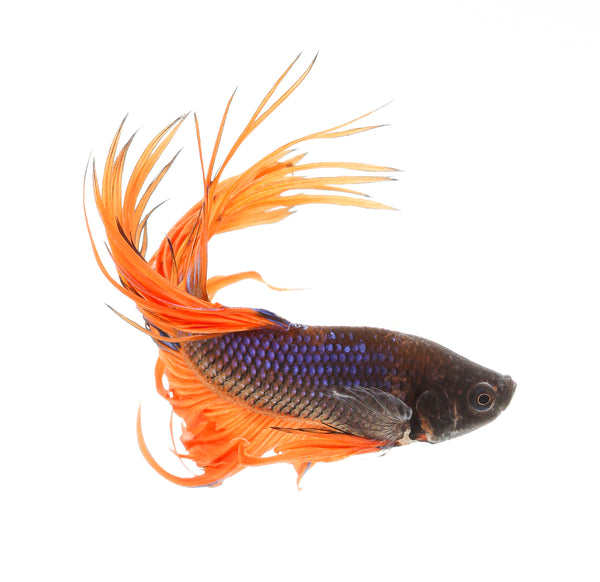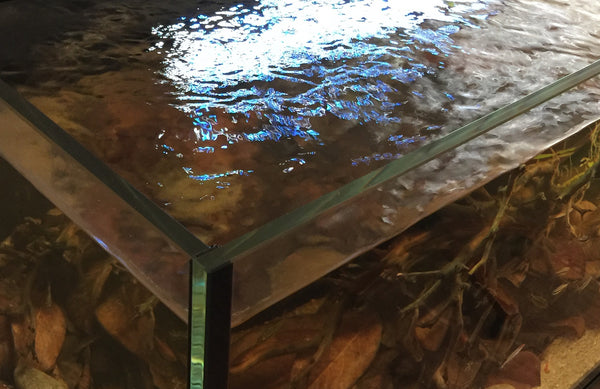- Continue Shopping
- Your Cart is Empty
What's Better for Bettas?
Some of the most enduring fantasies in our hobby are the way we perceive certain fishes are "comfortable" being kept. Fantasies which have, unfortunately, trickled beyond our little enclave of the hobby and into popular consciousness...
If you're like many fish geeks, at one time or another, you've probably kept at least one Betta at some point in your "career." Most likely, a "fancy" variety, purchased in a little cup, and then unceremoniously added to a little bowl somewhere.

Until not all that many years ago, this was my impression of Bettas in the aquarium hobby. One species (B. splendens), small bowls and cups, and improperly kept, dangerously inbred, low-quality fish found by the million at "big box" pet stores. And of course, for the longest time, I believed that these fish favored the confining, decidedly not-so-good environment of a small container of water.
And, how could you fault me? That's kinda how they've been "sold" to the world for generations...

Sadly, the cultural myth of Bettas being adapted to this kind of "micro-environment" has endured in both the hobby and popular culture, and we're all pretty much convinced that they live exclusively in little tiny puddles in Thailand, Cambodia and other parts of Southeast Asia.

And the sad part is that there is a little hint of truth to this.
Sure, they are found in little puddles and evaporating pools of water along roads, ditches, and rice paddies...but it's because of their excellent survival capabilities, clinging to life in evaporating puddles, rather than out of some innate preference for tiny spaces. They have good jumping capabilities for a reason, right? I'd venture to guess that it's to help escape from these little tight spots when the water gets really nasty!

And of course, because they're often seen in their native habitats in these little puddles and such, and are extremely adaptive to survive (note the word- "survive") such tight spaces with lower water quality...and we hail their remarkable ability to tolerate the nasty conditions found in these desiccating tracts of water, because of their "labyrinth organ."
And that's where it gets a bit weird to me...
You see, by extension, we can use this to justify the fact that they are best kept in smaller bowls and such by hobbyists of all skill levels. It's almost like they're perceived by many of us non-specialists to be just like annual killifish, ecologically adapted to live in evaporating puddles as part of their life cycle, when the reality is that these fish can live for 5 years or more with proper care!
And what happens, as a result, is that they are "humanely" kept in little bowls and cups and displayed this way at fairs and carnivals and even at pet shops. Now, the "pet shops" part is a bit of a challenge; however, at least these people have some skills and passion for animals. The fish stores are probably the best place for this practice, because they typically have qualified, knowledgable fish people taking care of them while there, and access to better equipment, food, and water...
Oh, and the better qualified caregivers are in a position to explain to potential purchasers that these fish actually require some care and skill to keep healthy and happy. They're not the aquatic equivalent of an "Air Plant" or "Pet Rock!" And typically, if someone is at a tropical fish store, they have more than just the most cursory interest in tropical fishes, so...
Yet, the fact is, these fishes are perceived as best being kept in such sketchy conditions. What about water quality, temperature control, etc...? A better way?

Sure, they are kept in cups because they can survive for a time in because they can breathe air when the oxygen level in the water gets too low (ie; when the water quality declines), and therefore sellers will use the cups for convenience. It doesn't mean that they should be kept in them.
Oh, and the fact that male bettas can and do beat the shit out of each other when kept in aquariums together has helped make the "cup thing" as a "standard", if not "preferred" method to keep them in many retail situations. I mean, otherwise, you'd have like 50 male bettas scattered throughout the store in 50 different tanks, right? Hardly practical for inventory/control purposes, I suppose! Females are often kept in "sorority" situations, with several in one aquarium (we have many Betta fans who do blackwater aquariums for their "sororities!")
Sure, males can be kept singly with other fishes in a well thought-out "community tank", although the males tend to be somewhat anti-social in a lot of situations. Ideally, a 5-or 10- gallon heated, filtered tank for a single male is optimal, right? Yet, we're faced with the strange dichotomy of knowing the best way to keep them, but displaying them in a way that sends an erroneous message to the general public.
A bit of a disconnect, for sure!

(image by Naray156, used under CC BY-S.A. 4.0)
Now, it's easy for me, who doesn't face the economic realities of owning a brick-and-mortar fish store, to sit here and take "pot shots" at this practice. And that isn't the point. I think, however, that we can use this longstanding practice as a springboard to more sustainable aquarium practices.
Yeah, I get a feeling that there could be a better way to address this.
What about the LFS, which by some necessity keeps the Bettas in bowls, also having a display or two or three replicating their natural habitat; or just a nice, well-thought-out aquarium featuring a specimen, located adjacent to the Betta selections? Not only would this address the correct way to keep these fish, it could also prove to be a good "sales vehicle" for aquariums and related equipment and accessories, right?
Removing part of the disconnect which exists...
Yeah.

I suppose it boils down to us as a hobby doing a better job at communicating to the general public the optimal conditions to keep these fishes under. The idea that bettas are a sort of "maintenance free pet for the kids!" is lunacy. Perpetuating the "Betta bowl" thing without this context is the real disconnect here. It's another case where a little understanding of the natural habitats of the fish is possibly the best "compromise" here, right?

When we understand the wild habitat of the fishes we keep, we can strive to at least replicate them on some levels, right? Plus, educating the public about this aspect of the Betta gives us an opportunity to create new aquarium hobbyists, and for people to understand the world around them...
Now, look, breeders often keep these fishes in temporary quarters and in containers which are not exactly what what many hobbyists would consider as "permanent" or "optimal" for many hobbyists' skillsets and aspirations. However, they are willing to put in the work to maintain these containers and such. They understand the basics of fish care, and employ practices which assure the health and well-being of their fishes religiously...And of course, just because we can keep them this way doesn't mean it's the proper thing for the fish, or for newcomers to the hobby, right?
Now, look- my little piece here is not exactly an earth-shattering, hard-hitting expose on this... We've had these discussions in the hobby for decades. And most of us agree that the way these fishes are typically presented to the public is problematic. I think that, as we constantly discuss the pressures facing the aquarium hobby, that the idea of educating ourselves and the public about the habitats from which these fishes hail is the way to go.
Oh, and there is that interesting fact that are like 70-plus recognized species in the genus Betta! The possibilities to keep these interesting fishes in uniquely-configured aquariums are significant.

And often, the habitats are as interesting as the fishes which reside in them. The idea of replicating the natural habitats of our fishes in a functional and aesthetic way is part of the allure to me! And these environments are really interesting!

When you dig a little deeper, as many experienced Betta enthusiasts have, you find out that they generally come from much larger, more permanent, and thickly vegetated habitats than we commonly perceive them. And a greater variety of them, at that...Little pools of water, rice paddies, sluggish streams, and small marshes choked with vegetation, leaves, branches, etc.

Of course, this is where my interest comes in...They are often found in habitats that are just like the ones we play with: Tannin-stained, botanical-material packed, and uniquely interesting!

And of course, with all of these interesting species, there are, of course, some which have adapted to different types of niches, like under leaves and submerged branches, etc. Opportunities to keep them in proper, interesting situations abound!

And of course, it's kind of hard to replicate such habitats in a tiny cup or bowl of water, so why not set up an aquarium just for them? Right? Like, the allure of the habitats themselves can provide enough motivation for many to create unique aquariums, right?

Something with some small rocks, wood, and a lot of leaves and sturdier botanicals! That familiar stuff...Yeah, we're good at that, aren't we?

And you might want to experiment with a pure "botanical substrate" of mixed leaves and some of the smaller seed pods and such, to really create a more accurate portrayal of the surprisingly diverse habitats from which these fishes come.

Many of you have shared with us a number of cool shots of your wild Betta botanical-style aquariums, and these are perfectly suited to these unique fish!

And a number of you have created dedicated paludarium-type tanks just for wild Betta species, and your fish rooms are filled with blackwater/botanical systems designed to permanently house many of these interesting species.

The variety of Betta species is so incredible, each with unique color patterns, morphology, and requirements that you might just devote a bunch of tanks to them...a really fascinating "hobby within a hobby!"

Hopefully, this embarrassingly generalized, incredibly short visit to the "alt Betta" world may have provided you with some incentive to look more closely at these captivating fishes, and to keep them in far more natural, interesting conditions than you may have previously even considered.
Again, I find it necessary to reiterate that have no illusions about this being some big, revealing look at the controversies and allure of Bettas, filled with new information and the solutions to every problem! That was not the point...However, I think such a presentation can create a discussion on this stuff, right?
It's important to look at some of the areas of our hobby which could use a bit of attention from time to time. Areas which need a bit more discussion and clarification. Areas in which our experience replicating specific types of aquatic habitats can help push forward the possibilities of success with many species of tropical fishes, including, of course, Betta species.

Hopefully, the "Betta Bowl" of the 21st century will be a properly-outfitted small aquarium with filtration, heat, botanicals, blackwater, and plants, a far cry from the popular, yet shockingly one-dimensional way we've kept these fishes for so many years.

Learning or applying new things about fishes that you may have taken for granted for years is not only humbling- it's fascinating, enjoyable, and makes you realize just how awesome the aquarium hobby really is!
Keep exploring. Keep striving. Keep sharing!
Stay fascinated. Stay curious. Stay creative. Stay skeptical.
And Stay Wet.
Scott Fellman
Tannin Aquatics






Scott Fellman
Author